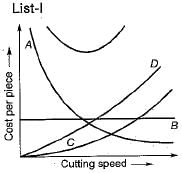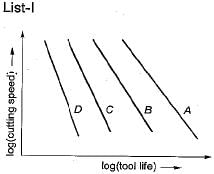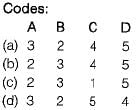Test: Metal Cutting & Tool Materials - 2 - Mechanical Engineering MCQ
10 Questions MCQ Test Topicwise Question Bank for Mechanical Engineering - Test: Metal Cutting & Tool Materials - 2
Match the List-I with List-II following:

List-II
1. Tool-change cost
2. Machining cost
3. Non-productive cost
4. Tool cost


List-II
1. Tool-change cost
2. Machining cost
3. Non-productive cost
4. Tool cost

Consider the following actions:
1. Mechanical abrasion
2. Diffusion
3. Plastic deformation
4. Oxidation
Which of the above are the causes of tool wear?
1. Mechanical abrasion
2. Diffusion
3. Plastic deformation
4. Oxidation
Which of the above are the causes of tool wear?
| 1 Crore+ students have signed up on EduRev. Have you? Download the App |
What is the variation of cutting speed with tool life on log-log scale?
Match the List-1 with List-lI:

List-II
1. Cast alloy
2. Ceramic
3. Carbide
4. Ideal material tools
5. HSS

In idealized chip formation, built up edge will break off and remove some of the cutting tool materials, thereby reducing tool life. Which of the following steps prevent built up edge?
1. Increasing cutting speed
2. Increasing feed rate
3. Increasing ambient work-piece temperature
4. Decreasing rake angle
5. Reducing friction
Select the correct answer using the code given below:
Why does crater wear start at some distance from the tool tip?
Surface obtained for circular generatix and straight line directrix would be
Which of the following indicate better machinability?
1. Smaller shear angle
2. Higher cutting forces
3. Longer tool life
4. Better surface finish
Dynamometer is a device used for the measurement of
The primary tool force used in calculating the total power consumption in machining is the
|
45 videos|314 tests
|
|
45 videos|314 tests
|












